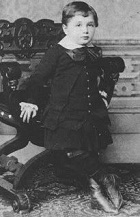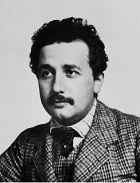Albert Einstein and the most elemental atomic theory
Albert Einstein's birthdate was less than a week ago, on March 14, in the year 1879. Happy belated birthday, Albert!

Albert Einstein, age 4
As a slightly overdue commemoration of Albert Einstein's 133nd birthday, I would like to make a quick note of his most "elemental" contribution to atomic theory-he was the first person to show a way to prove the existence of atoms-using an ordinary microscope!
Atomic theory
When you really get down to it, "atomic theory" begins with a claim that matter is made of atoms. This sounds obvious enough to us today, but not very long ago, relatively speaking, chemists and physicists were known to debate this idea fiercely. The idea of atoms as a shortcut for thinking about how matter worked seemed quite useful even more than a century ago-but then again, so did ideas like a stationary earth at the center of the universe. When Einstein was a young man, atoms had never been observed. Was the idea of atoms actually "real?" Or was something else, perhaps something unexpected, going on?
1905 was a good year
The year 1905 was a good year for 26-year-old Albert Einstein. While working at the patent office in Bern, Switzerland, he completed his PhD dissertation. He published his Special Theory of Relativity, which later led to the General Theory of Relativity, which led to his designation as "the father of modern physics." Einstein also in 1905 proposed that light energy can be absorbed or emitted only in discrete packets called quanta, a provocative contradiction of the then-prevalent wave theory of light-and this led to Einstein's winning of the Nobel Prize. Einstein in 1905 also explained the equivalency of mass and energy, expressed by the famous equation e=mc2.
Yet these were not sufficient world-changing, revolutionary advances in physics for a single year. Einstein also in 1905 mathematically proved the existence of atoms, and thus helped revolutionize all the sciences through the use of statistics and probability.

Albert Einstein, age 25
An atomic view of a liquid
Atomic theory says that any liquid is made up of molecules (invisible in 1905). Furthermore, these molecules are always in random, ceaseless motion. The average behavior of these molecules produces the overall properties of any liquid that we observe. But Einstein realized that this random chaos of jostling, invisible molecules would produce statistical fluctuations-for example, once in a while a small group of invisible molecules could, just for a moment, move in mostly the same direction. Then, another nearby group of molecules could for a moment move mostly in a different direction. A visible object, immersed among these invisible, randomly jostling molecules, wouldn't move much most of the time, since it would normally be buffeted from all sides evenly-but then occasionally it could be "pushed" in one direction and then moments later pushed in a different direction, showing a "zigzag" motion.
Brownian motion
The jittery motion of tiny observable particles had been described by botanist Robert Brown as early as 1827, and was not surprisingly known as Brownian motion. Measuring this motion, however, and explaining it mathematically had proven extremely difficult. What was required, in short, was Einstein's realization that even though observable particles are much larger, they still generate pressure the same way as the invisible molecules in which they are immersed. So, if the concentration of large particles varies, they too flow to even out their concentration just like the atoms and molecules in which they are immersed.
Using this insight, and some associated mathematics, Einstein was able to accurately calculate the average distance an immersed visible particle would travel in a given time. His mathematical laws governing the movements of invisible particles could be tested and measured by observing the motion of the visible- simply using a microscope and a stopwatch, and a fluid containing many uniformly sized tiny, yet visible, particles. Although this was quite tricky to test a hundred years ago, eventually Einstein's calculations were fully confirmed by Jean Perrin in 1909, winning Perrin the Nobel Prize.
Some implications
The existence of atoms and molecules was confirmed. With Einstein's calculations, one could determine the size of these invisible atoms and
molecules. Also, the idea that heat is the result of the motion of atoms and molecules was confirmed. And finally, the vital importance of statistics and probability in physics had been established. This was a pivotal achievement, considering the truly revolutionary discoveries in quantum mechanics that were about to ensue. More broadly, Einstein's use of statistical fluctuations, and probability theory, eventually revolutionized the study of all complex systems-weather, climate, stock markets, and evolution, to name a few-and forever improved our understanding of how the world works.
____________________
 Paul Bowersox is a regular contributor to the ANS Nuclear Cafe and admirer of the achievements of the nuclear pioneers.
Paul Bowersox is a regular contributor to the ANS Nuclear Cafe and admirer of the achievements of the nuclear pioneers.






